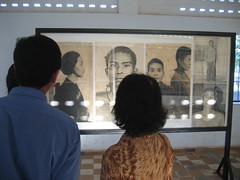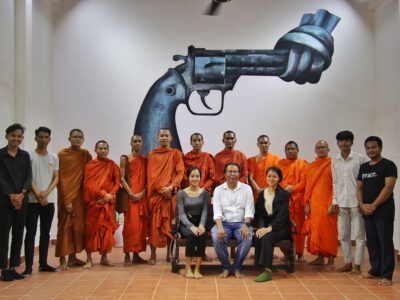In 1970 a boy of ten Nhem En joined Khmer Rouge. He was sent to study photography in China, and six years later became a photographer of death at Tuol-Sleng genocide museum, the site of S-21. He told journalists in 2001 about his past work that “they [the prisoners] always believed that after the Khmer Rouge arrested them they would die or face problems. So when I took photographs, their faces looked scared, eyes full of pity, hands in handcuffs.” Macam-macam believes these photos are among the most famous ones ever taken by a South East Asian in our modern tragedy era.

Photo courtesy of Colin Mutchler
After a heavy rain, it begins to shine
The war is over. After bitter year 1975-1979 Cambodian history had her new chapter, the map of the country has emerged once again in travel guidebook and became one of the top tourist destinations in South-East Asia. For survivors, refugees, and their children, it is hard to be away from the infamous killing field. Individual and collective identity of Cambodian citizens is yet in question. The winds of war has resulted a new generation of Cambodians living outside their home country. And a large percent of immigrants began new lives in the United State, France, Australia, Canada, and in other coutries in many parts of the world. They have to live in new communities and learn to cope with the past psychologically and culturally. A Cambodian-American Puthearorth, who at age 14 left his home country for the United States, has been educated mostly in this new world, exposured to this foreign culture, and has to handle the way of thinking and living not in a single way. He reflects the matter of his identity that
“as a Khmer growing up in the American cultural society, it is almost impossible to maintain the true identity of who I really am; in fact, this is true across the board with many immigrant children in this country. The Identity Conflict is simply a question of giving up the old one and embrace the new one, maintaining the old and not accepting the new, or give up a little bit and take in a little bit.”
Two-way communication tool weblog can be deployed as way for people to comfortably tell their own stories, thoughts, and memory of the past. “Though it is only appropriate to identify myself as a Khmerican, it is almost impossible to understand what that is like,” he added.
Over two decades after the fall of Pol Pol regime, newspaper announcement of missing person is a mean for survivors of war-torn Cambodia. Day after day a Cambodian weblogger Mean Lux reads the paper as he hope to find his uncle's name.
In Phnom Penh, a foreign tourist describes life in this capital city in a way that can lead to an understanding about life in general of Cambodian people. One day he witnessed children who have to work for a living, and wrote that
“As you walk the streets, you are constatly bombarded with requests to buy books or newspapers from locals with baskets of the reading material hanging from around their necks. But these sellers are not adults, or even teenagers. They are almost exclusively young kids, aged anywhere from 5 to 10.”
Julie D highlight situation of the country that “over 40% of Cambodians have never attended school. More than a quarter of the adult population cannot read or write. In this struggling country, thousands of children, both rural and urban, grow up without proper nutrition, without proper education, without any of the basic opportunities that we all take for granted.”
In Siem Reap, through arts, exhibitions at The Land Mine “Museum” offer foreign tourists an understanding of year-long civil war nation. The museum was founded by a former Khmer Rouge soldier. “It is also inhabited by a dozen or more children who are also land mine victims.“
An American citizen who worked in Cambodia before Khmer Rouge came to power, and has currently returned home from a trip to this country has a piece of opinion by comparing bigger Cambodia to tiny island Hong Kong:
“I have traveled in about 60 countries since 1969, and what I saw in Cambodia was rivaled perhaps only by Hong Kong's infamous “walled city,” a 12-acre No Man's Land, which was torn down in 1999.”
News headline in the New York Times “Why Is Everybody Going to Cambodia” makes buzz in blogosphere. Keno, a Cambodian weblogger commented “while surfing the web today, I found a very good article newly published which answer what's special about Cambodia, and why more and more people visiting here.”







2 comments
Very well writtne article & thanks for sharing the story to the world.